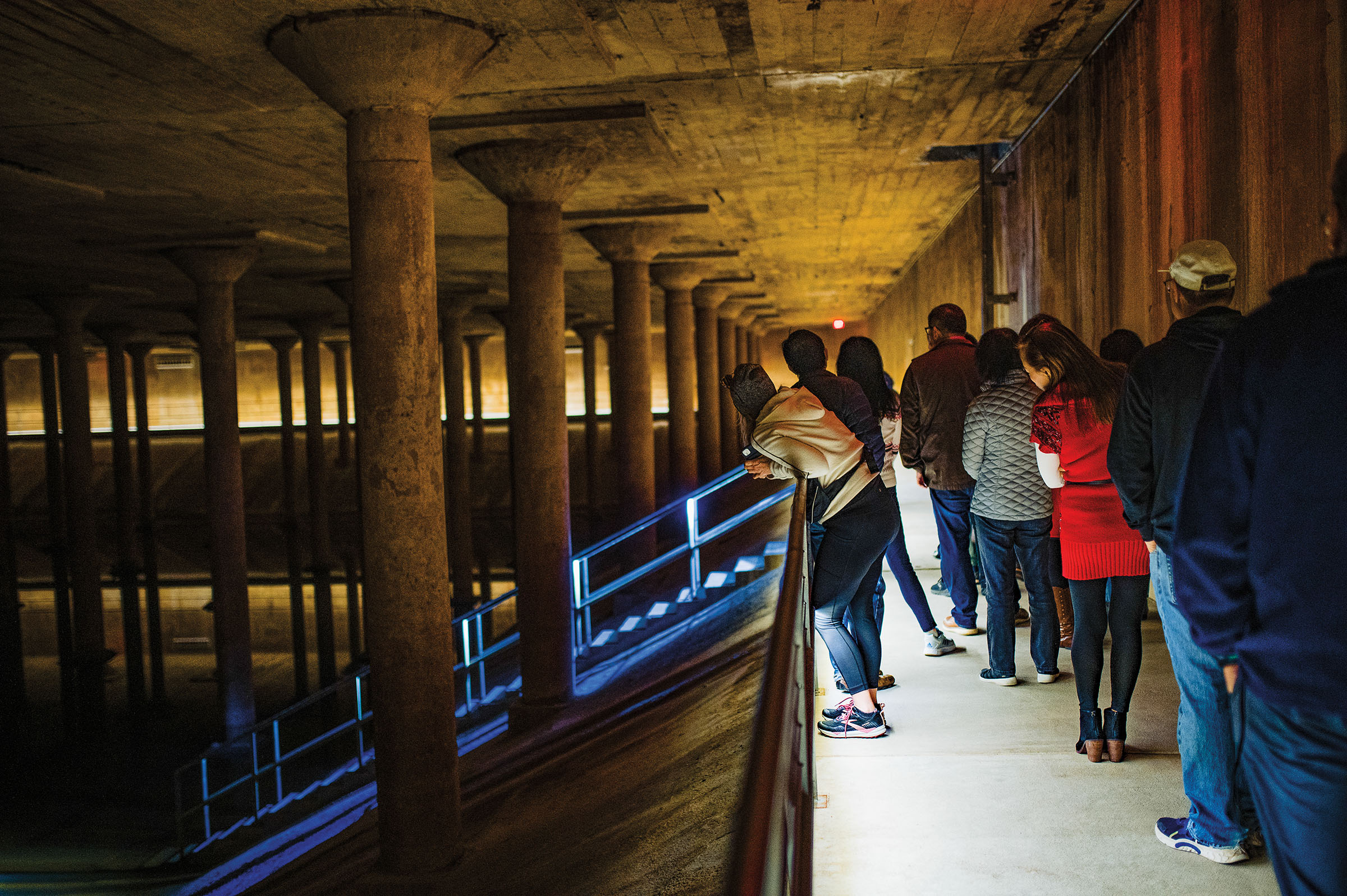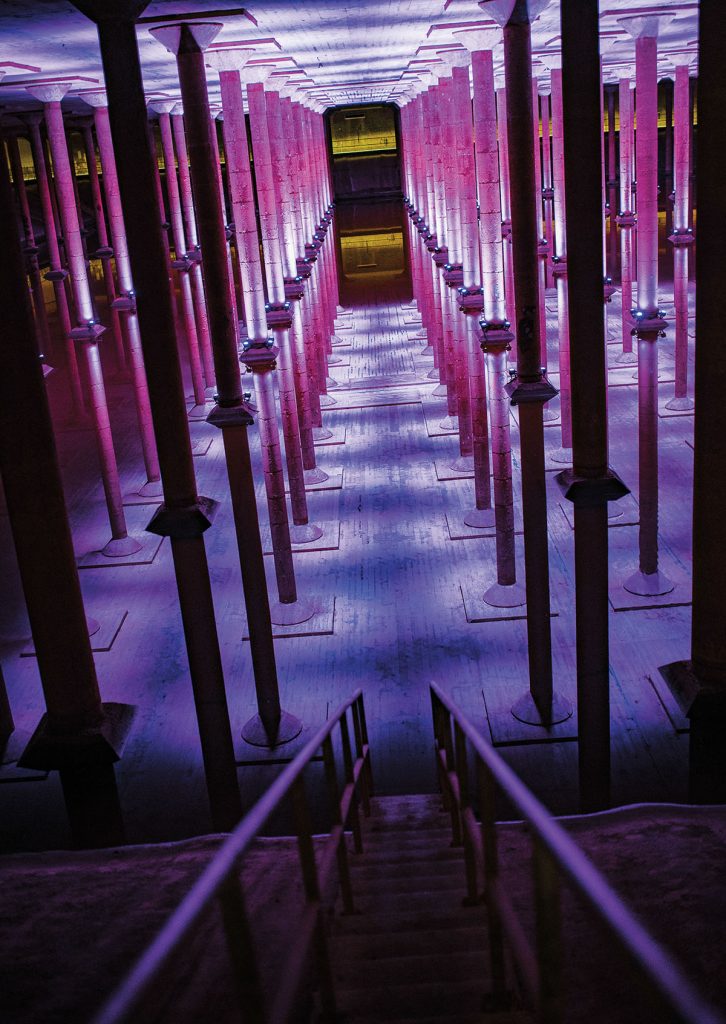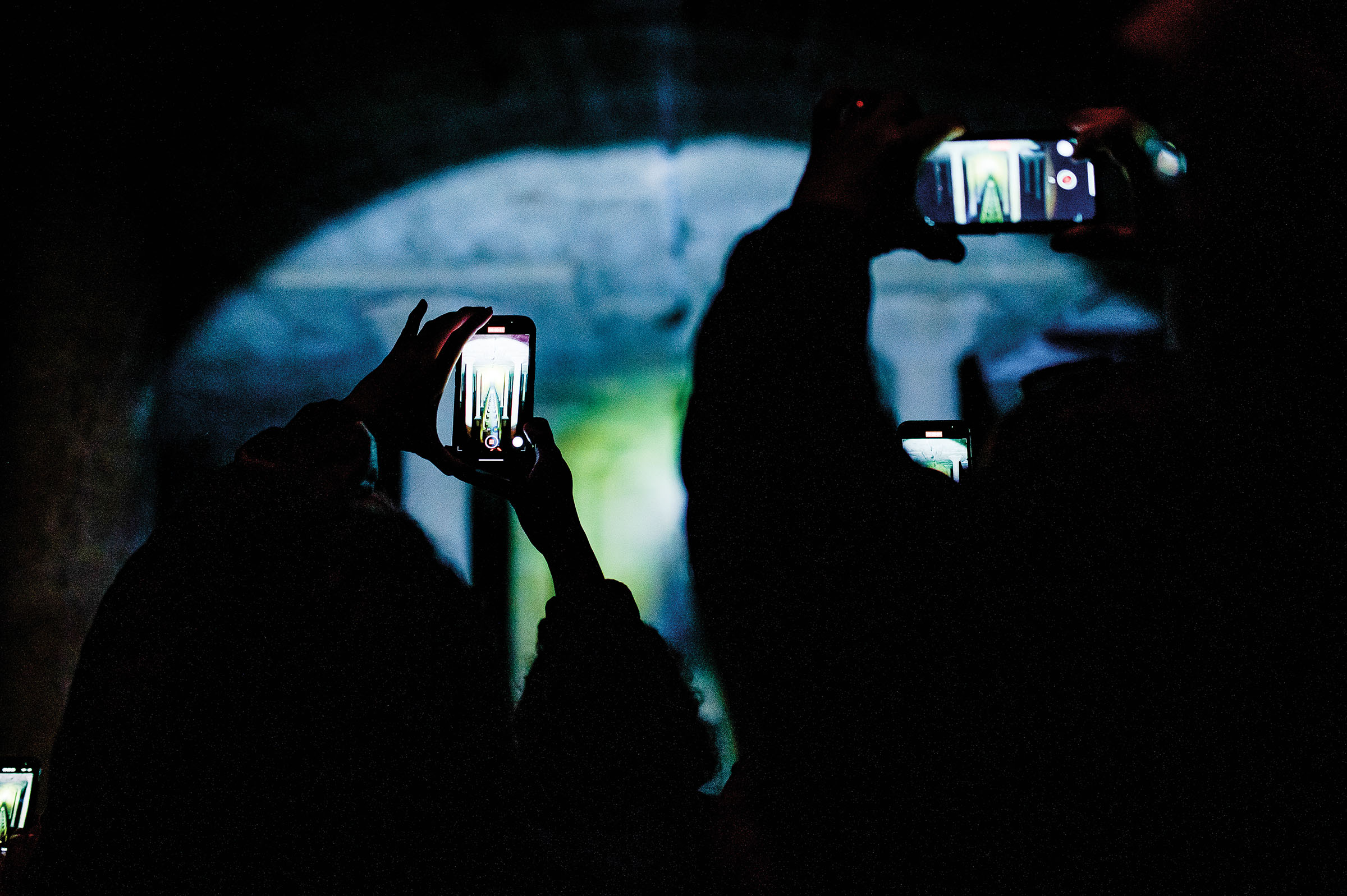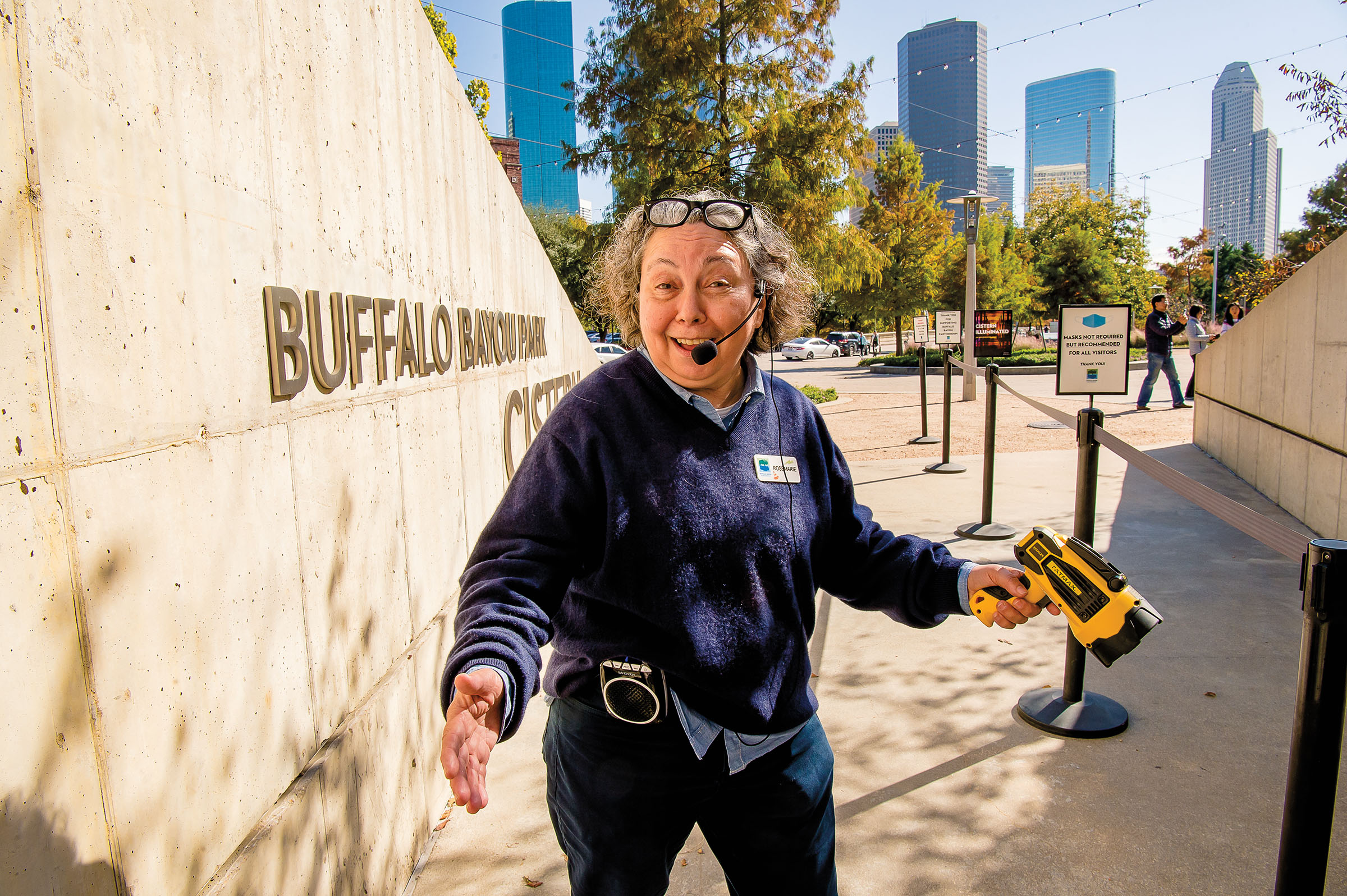
From the first note our tour guide sings across the Buffalo Bayou Park Cistern, we know we’re in for something special. Here we are, a group of strangers, standing underground within a reservoir about the size of a city block, struck silent by Rosemarie Croll’s song, “The Cistern Is.” When she’s done, her voice floats over the water. The closing tones ring for 17 seconds as the sound echoes between the calm pool and the cistern’s 221 concrete columns. No one moves. One woman pulls out tissues.
With its otherworldly acoustics, Buffalo Bayou Park Cistern inspires many such moments of collective effervescence, the sensation of well-being sparked by a powerful shared activity. The underground cavern, an industrial relic located on the edge of downtown Houston, may seem like an unlikely refuge, but our walk down a tunnel from the brightness of Buffalo Bayou Park into this subterranean realm of water and columns is moving.

The City of Houston built the cistern in 1926. It was decommissioned in 2007, and public tours began in 2016.
I suspect W.R. Holway, the civil engineer who built this 87,500-square-foot cistern in 1926, could not have imagined the cistern would inspire sacred experiences almost a century after it was created. Or could he?
“It’s one of my favorite ponderances,” says Croll, who’s been the senior cistern attendant since it opened as part of Buffalo Bayou Park in 2016. “Holway made this for the city of Houston to provide water. He never knew that anyone would see it, and yet he still made it beautiful. It’s now an architectural monument.”
Cisterns were once a common method used to store water with minimal evaporation. Holway’s cistern is one of at least two in Houston, though little is known about the other, which is privately owned. The Bayou Park cistern’s aesthetics, both visual and auditory, are so striking that it’s hard to imagine Holway did not design it with an audience in mind. But in reality, its purpose was utilitarian.
Holway, a Massachusetts native who attended Dartmouth College and Massachusetts Institute of Technology, first came out West in 1918 to run a new water filtration plant in Tulsa, Oklahoma. He also designed and oversaw the building of a new water system still used by the city of Tulsa. In 1926, when Holway was 33, the city of Houston hired him as a consulting engineer for the cistern, which would hold 15 million gallons of the city’s backup drinking water supply, pumped from artesian wells hundreds of feet below. Over the 95-day construction project, Holway’s crew molded 6,000 cubic yards of concrete and 800,000 pounds of reinforced steel into this hidden reservoir, which was needed for Houston’s fast-growing population. The cistern held water until it sprung a leak and was decommissioned in 2007.


Croll believes Holway was likely inspired by the Basilica Cistern in Istanbul, Turkey, which was built in the sixth century and is famous for its marble columns adorned with carvings of snaky Medusa heads. Holway’s grandson, Bill Hamilton-Holway, a retired Unitarian minister and unofficial family historian, agrees with Croll’s theory.
“In his studies at MIT for his degree in civil engineering, W.R. studied all the great water supply systems around the world,” says Hamilton-Holway, who lives in California. “My guess is he was intrigued by the Istanbul cistern and saw it as a model for addressing Houston’s need.”
Hamilton-Holway points to his grandfather’s design of the Pensacola Dam on the Grand River in northeastern Oklahoma as another example of how engineering principles can be inherently elegant. “It’s renowned for being the longest multiple arch dam in the world at 1.1 miles,” he notes. “Multiple arches are an engineering method for distributing the weight of water. They are labor intensive to build, and, as anyone who has stood below the dam knows, they are also beautiful.”
Be it a dam or a cistern, Holway was inspired by ancient engineering principles, which resulted in functional forms that are effortlessly graceful. During tours of this unexpected urban temple, Croll relays fun facts and cool details. She explains the early, loosely monitored days of Houston water sanitation, like in 1903 when the body of a 3-foot eel was found blocking the water pipe of the women’s ward at the downtown police station. Croll shows us the cistern’s industrial concrete walls and ceiling, shining her flashlight to illuminate the wood grain imprints of the boards used to hold the concrete in place almost 100 years ago.
Notes from the Underground
The Buffalo Bayou Partnership schedules a range of activities at the Buffalo Bayou Park Cistern. All events are open to participants ages 9 and up:
History Tours: Wednesday through Sunday, 30-minute guided tours highlight the cistern’s engineering and architecture as well as the history of Houston’s water system. Ticket costs $12.
Sound Healing Meditation: Held at 10 a.m. on Saturday and Sunday, these 30-minute sessions offer meditation with the reverberations of crystal singing bowls and wind chimes echoing through the cistern. The sessions are a collaboration with Union is Creation and Youniversoul. Guests should bring their own cushion or mat. Ticket costs $15.
The Buffalo Bayou Park Cistern is at 105 Sabine St.
713-752-0314, ext. 301; buffalobayou.org/visit/destination/the-cistern
The cistern’s existence today is a resounding triumph in the category of near-misses, for it could have been a parking lot. After it was decommissioned, the cistern was largely forgotten until 2012, when the nonprofit Buffalo Bayou Partnership embarked on a project to upgrade Buffalo Bayou with hike-and-bike trails and lush green parks along the river. While looking for potential parking areas, park designers came across the cistern. To investigate, a few of them climbed through a maintenance hatch—the only entry to the cistern at that time—and descended ladders into pitch blackness. Like treasure hunters, they shined their flashlights upon the defunct water reservoir and were awed by what they found. “Once they saw how beautiful the cistern was, they knew it had to be preserved,” Croll says.
After an architectural overhaul that included a new concrete entrance and walkway around the pool’s perimeter, the cistern opened to the public in 2016. Along with multiple weekly history tours, Buffalo Bayou Partnership stages art installations and programming such as the Underground Sounds concert series. A past installation by Berlin, Germany-based multimedia artist Anri Sala included a projected image of a floating turntable over the cistern’s water and a musical soundtrack.
During a September performance by the local octet Two Star Symphony, I was absorbed in the plaintive vibrations of a cello, stand-up bass, and drums. “With that echo, it takes some adjusting,” noted one of the musicians following the performance. “We are looking for that perfect note of resonance with the cistern.”
Karen Farber, the partnership’s vice president of external affairs, says the nonprofit seeks to “amplify the experience of awe” the cistern inspires.
“Every artist who enters the space is interested in activating it with art,” she says. “At the moment, we are most focused on enhancing the inherent qualities of the space—for example, its architecture, acoustics, and reflection—rather than competing with or distracting from them.”
The day after my tour, I return to the cistern for a “sound healing meditation.” Saumil Manek, a cheerful man in flowing white clothes and aviator-style glasses, greets the group before taking a seat to play crystal singing bowls. The music goes deep inside my body, resonating with my cells and organs.
I’d been skeptical about the “healing” capacity of this experience, but now, sitting on a yoga mat in this refuge, I feel the reverberations unspool tension. It’s yet another flash of collective effervescence, a taste of how peak happiness comes through shared moments such as these. And it’s a legacy of aesthetic loveliness, whether intentional or not, left to us by one gifted civil engineer.








